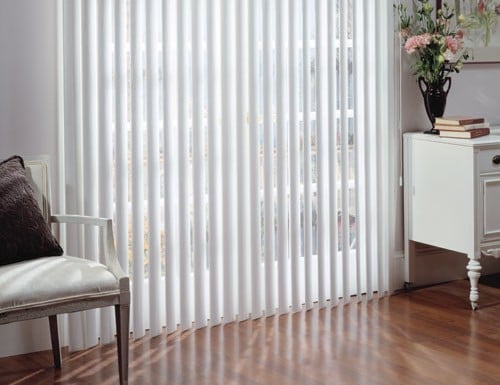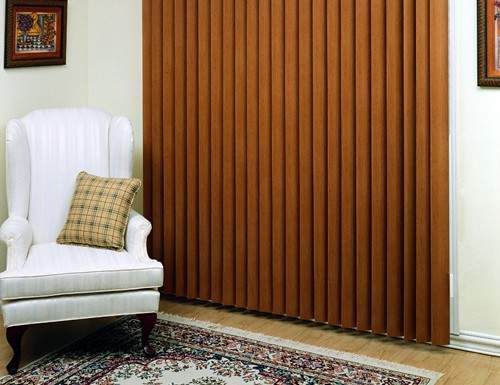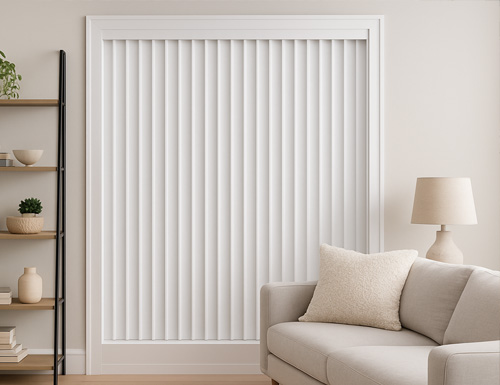Lexi Westingate | Blinds Chalet Design Team
Updated: Sep 23 2024

Vertical blinds are a practical, stylish choice for large windows, sliding glass doors, and patio doors. Installing them yourself is a great way to enhance your home’s look while saving on costs. With the right tools and a clear plan, the process is simple, even for DIY beginners. Here’s a step-by-step guide to help you install vertical blinds securely and ensure smooth operation.
1. Preparation: Tools and Measuring Your Windows
Before starting, gather your tools and measure your windows carefully to ensure a perfect fit.
Tools You’ll Need:
- Measuring tape
- Pencil
- Power drill
- Screwdriver
- Level
- Step ladder
- Mounting brackets and screws (usually included)
- Measure the inside width of the window frame at the top, middle, and bottom. Use the smallest measurement to ensure the blinds fit snugly.
- Measure the height from the top of the inside frame to the window sill, using the longest measurement for full coverage.
- Measure the width of the window frame and add 3 to 4 inches on each side for better coverage and light control.
- Measure the height from the top of the window frame to where you want the blinds to end, typically a few inches below the frame.
2. Marking and Installing the Mounting Brackets
With your measurements complete, it’s time to install the mounting brackets that will hold the headrail.
Marking Bracket Placement:
- Use a pencil to mark where the mounting brackets will go. For inside mounts, brackets go on the inside top of the frame. For outside mounts, mark just above the frame. Make sure they are evenly spaced.
- Drill small pilot holes where you’ve marked the bracket placements to make it easier to screw them in without damaging the frame or wall.
- Attach the brackets using the provided screws, ensuring they are securely in place. Use a level to check that the brackets are even before tightening them fully.
3. Attaching the Headrail
After securing the brackets, it’s time to attach the headrail, which holds the slats and controls the blinds.
Inserting the Headrail:
- Lift the headrail into place, aligning it with the brackets. Depending on your blind model, it may click or snap into position. Make sure it’s secure and properly aligned with the window.
- Before proceeding, test the headrail by sliding it back and forth to ensure it moves smoothly.
4. Installing the Vertical Blind Slats
Once the headrail is installed, it’s time to attach the slats.Attaching the Slats:
- Starting from one side, hook or clip each slat onto the headrail’s carriers. Ensure each slat is secure and hangs straight, without touching the floor or dragging.
- After attaching all the slats, test the wand or chain to ensure they open, close, and slide smoothly.
5. Final Adjustments and Safety Features
Now that the blinds are up, make any necessary adjustments and ensure they’re safe for everyone in your home.
Adjusting the Length:
- Some models allow you to remove extra slats if they’re too long. Follow the manufacturer’s instructions for adjusting the length.
- For corded blinds, install a cord cleat to keep the cords safely out of reach of children and pets. Wrap the cords around the cleat to prevent accidents.
Conclusion: A Smooth Installation for Long-Lasting Vertical Blinds
Installing vertical blinds is a straightforward DIY project that can transform any room. By taking accurate measurements and following these steps, you’ll ensure a secure fit and smooth operation. Vertical blinds provide excellent light control, privacy, and style, making them ideal for large windows and sliding doors.
For custom vertical blinds or professional installation services, visit BlindsChalet.com to explore a wide range of options tailored to your home.













